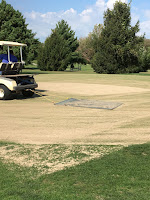Almost two weeks ago we set out for our yearly fall greens aerification. The reasons we do pull cores is to try and remove as much organic matter in the top 3 to 4 inches.
 As can be seen in the picture of the soil profile, the top layer shows a little bit darker soil mix from the bottom of the profile which is the original greens mix. We pull that organic matter out and replace it with fresh sand. I do have some concern of the darker soil at about the 4-5" depth, where we are not able to get sand into that area of the profile at this time.
As can be seen in the picture of the soil profile, the top layer shows a little bit darker soil mix from the bottom of the profile which is the original greens mix. We pull that organic matter out and replace it with fresh sand. I do have some concern of the darker soil at about the 4-5" depth, where we are not able to get sand into that area of the profile at this time. Prior to our first day of aeration we will verticut greens, figuring this is the perfect time to get one of the practices in (we try to verticut 4 times in the spring and 4 times in the fall weather and schedules permitting). We begin pulling cores early while still dark and will start the process of picking up those cores.

We are blessed to see a great sunrise due to starting so early. Once the green is cleared and before we topdress, we will blow off any loose debris.
We will then topdress greens with about an 1" layer of sand, and will let that sand dry for most of the morning. When we have felt some of it has dried enough, we start to drag that sand in using metal drag mats. We are hoping to pick up the dry sand and have it start falling and filling in the aerations holes.
We will then let that sand dry some more and then do a final drag, then we will roll, and change cups so the green will be ready for the next day when we reopen that nine holes. We will also fertilize the greens so they can heal properly. We will have already fertilized previously about a week prior to aeration so greens would be actively growing when the aeration process was started.


If the weather cooperates, the greens should be back to normal, or at least to the point that we are not blamed for missing putts which is usually in 11-12 days.
With our course set up and business model, we will aerate one set of 9 holes, which will stay closed for the day. On day two we will open up the just completed 9 and close the other. With 2 acres of greens we can do each 9 in about 10 hours per day. With the 6 to 7 staff members we will usually have during the process, this is what works best for us. We will always shoot for spring aeration in the first full week of April and the fall aeration is scheduled for the first full week of October.
I do remember working at another course with bigger staff, and at different times of the year, where we would work from sun up at 5 AM to past dark which would be between 8 and 9 PM (or later) and would do all 3 acres of our 18 greens. And to follow up we would have a couple of our students water after, (we had a quick coupler system there). They loved the overtime, but I know the following day we would all be about useless.
I would love to hear how others attack this practice.
Thanks for reading!
Mel





No comments:
Post a Comment